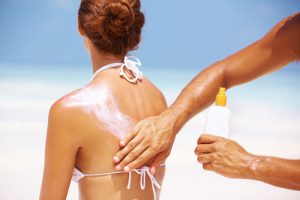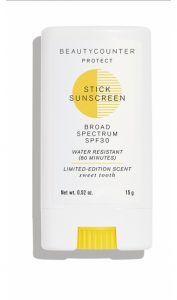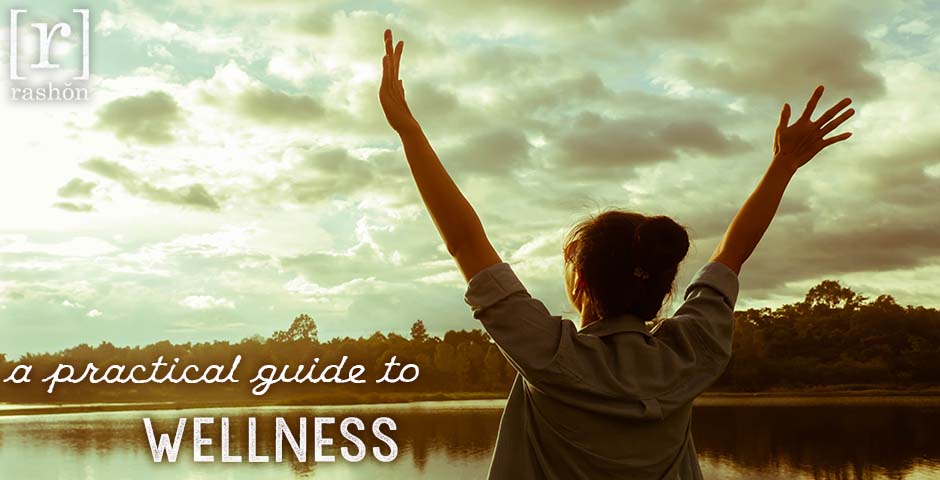Hey there! So we made it through Objective 1 and 2, and are on to our next goal! You can go back and read all the Practical Guide posts and start the program at any time. Keep in mind that we’re making small changes that add up to HUGE results in your overall health. That means you have to keep up all the good work you did on the past objectives, and add in each new goal. So keep on drinking all that water and avoiding those damaged fats, while you work on this next step!
Objective #3: Upgrade to Safer Sunscreen
Timeframe: 2 Weeks
It’s getting warmer, and we’re all starting to spend more time outdoors. Y’all, here in Texas, we have to soak up all the outside time now – you know, before the temps skyrocket and it’s 105, and you’d rather do anything than step foot out into the sweltering summer heat. Or maybe that’s just me. Regardless, if you’re going to be out in sun, you need to protect your skin from sunburn. We all know that, right? But did you know that many sunscreens contain toxic ingredients, and can even do more harm than good?
If you’ve followed me for any length of time, you know that I’m extremely concerned about Endocrine Disruptors. Endocrine disruptors are chemicals that may interfere with the body’s endocrine system and produce adverse developmental, reproductive, neurological, and immune effects in humans. I won’t go into that fully here, but I do want you to click through that link to read more about what Endocrine Disruptors do in our bodies. It’s important to understand how the chemicals we’re exposed to every day – in our personal care products (including sunscreen!), household cleaners and those in the environment, affect our bodies, and our health! When you start learning more about the lack of regulation in personal care products, you start to understand the magnitude of the problem.
Here are a few statistics you should know:
- It takes 26 seconds for anything you put on your skin to be absorbed into your bloodstream. Let that sink in: whatever you put on your skin is absorbed directly into your bloodstream – and quickly.
- Of the ingredients in personal care products, 80% have never been assessed for human safety.
- The damage that chemicals can do to our bodies as adults is really awful, but keep in mind that damage in our kids’ bodies is even worse! With lower body weight, and developing/growing bodies, hormones, etc., they are at even greater risk with exposure to harmful chemicals.
- Studies are showing that even the smallest amounts of harmful chemical exposure over time can add up to a huge toxic soup in your body leading to increased cancer risk, among other health issues.
All of this being said, imagine a lifetime of chemical exposures – that’s why choosing safer products across the board is so vitally important. Choosing safer sunscreen, a product we all use almost daily, is a good place to start.
The Environmental Working Group has an amazing Sunscreen Guide that is packed with information. While I will be covering a small portion of that information here, I highly recommend clicking through to learn more about choosing safer sunscreens, what to look for and which brands are rated the highest. The EWG is a wealth of information about so many products, and I count it as a trusted resource for information.
A Couple of Ingredients to Avoid
When looking at sunscreens, these are among the top ingredients to make sure your product of choice leaves out:
- Vitamin A. A common sunscreen additive, a form of vitamin A called retinyl palmitate, can harm skin. Government test data shows more skin tumors and lesions with this ingredient, and when exposed to sunlight. So the ingredient added into the product for sun safety actually causes damage when exposed to the sun? Um, that’s scary. While the use of this ingredient has declined sharply over the past few years, it’s still used in many products.
- Oxybenzone. Oxybenzone is a common UV filter in sunscreen. Used because it effectively absorbs ultraviolet light, it’s also believed to cause hormone disruption and cell damage, which could promote cancer.
- Fragrance. Fragrance is a term that covers a whole host of evils. Companies are allowed to use the term fragrance as a general ingredient without having to list the chemicals that actually make up that fragrance. Many times, a “fragrance” is made up of hundreds of chemicals, all of which can be toxic, cause hormone disruption, cause allergic reactions and breathing issues, increase cancer risk, etc. These chemicals are NOT regulated in personal care products.
You should really check out the EWG’s Eight Little-Known Facts about Sunscreens. While I don’t want to beat this whole thing into the ground, I want to highlight a few things for you here. First, there’s no evidence that sunscreen actually prevents skin cancer. There are many risk factors behind skin cancer, and we can only control three of those factors: indoor tanning, exposure to UV radiation and sunburns. Sunscreen can be effective in helping with UV protection (though still not great) and preventing sunburns. High SPF is actually not so great. When you buy a higher SPF, it fools you into thinking you can use less and apply it less often, and that’s just not the case. The FDA no longer allows any SPF over 50. You’re best off buying SPF 25 or 30, applying liberally and often – every hour or so, especially if you’re in the water or sweating. Additionally, the higher SPF sunscreens have higher amounts of chemicals, so you’re exposing yourself, or your kids, to more chemicals with no real benefit. The final item I want you to know is that you need some direct exposure to sunlight – without sunscreen. Vitamin D is produced in our bodies when stimulated by sunlight. Vitamin D is vital for healthy bodies – it strengthens bones and the immune system, reduces risks of breast, colon, kidney and ovarian cancers and perhaps other disorders. Most of us are severely deficient in Vitamin D as it is. Now the amount of direct sunlight will vary depending on your skin. If you burn easily, you may only be able to be in the sun for 10 or 15 minutes. If you can tolerate more sun, getting about 30 minutes of direct sunlight is optimal. Keep in mind that you want to do this every day. Be sure that you have as much skin exposed as possible (NO sunscreen!) – so break out those tank tops and shorts, or your swimsuit, and let the sun do its thing!
Your Objective: For the next 2 weeks, do your sunscreen research, and choose and buy a safer sunscreen for you and your family.
I realize that two weeks may seem like a long time, but I really want to give you time to read up on this subject. It’s important to understand why some sunscreens are unsafe and ineffective, and why others are a better, safer choice. I also know that I’m asking you to throw out products you already have, and while that is a big ask, it’s for the safety and health of your family.
Action Steps
- Check out EWG’s Sunscreen Guide, which includes the best and worst sunscreens for adults and kids. You can also click through to read their report is which PACKED with info about sunscreen and sun safety. There’s also a search bar to enter your current sunscreen to see how it rates!
- Download the Healthy Living App from EWG. This app is awesome and allows you to check the ratings of your sunscreen, along with skincare, cosmetics and other personal care products, and even food. I use this app all the time, and it is a fantastic resource to have at your fingertips.
- Find a safer sunscreen option and buy it!
- Toss out those unsafe sunscreens. Don’t keep them as back up. Stock up on safer options.
Product Recommendations
There are tons of safer sunscreen options out there. These are a few that I have tried and recommend, in no particular order.
- Blue Lizard. You can also find this on Amazon. The reviews are worth reading, and I’ve found this to be a great sunscreen.
- Beauty by Earth. Okay, to be fair, I haven’t tried this yet, but I’m ordering it this week. It comes highly recommended by my friend Jennifer of predominantly paleo. This is what she and her kids use for their bodies, and they all love it. She does her research, and I trust everything she says, so I know it’s got to be good.
- Beautycounter Protect Stick Sunscreen for Face. I love this sunscreen stick. It’s the perfect size for applying to your face. It’s also super easy to apply – even the kiddos can do it. You just need a light layer, and it works great under make up as well. Beautycounter has a whole line of sunscreen products, and all of them are great. I can answer any questions you might have about these sunscreens. The lip balm with sunscreen is also fantastic!
This is just the tip of the iceberg in terms of safer sunscreen products. Check out EWG, and read all the reviews you can on Amazon and other sites to help you choose the best products for you and your family.
Over the next couple of weeks, I will be sharing more information about sunscreen and product safety in the Facebook group. For more info on that group, be sure to sign up for the Practical Guide to Wellness email list. I give email subscribers additional resources, and group members get even more than that. I’ve also got a fun giveaway for group members for this objective, so be sure to join us this week!
Additionally, if you’re interested in safer products, and living a healthier, more balanced life, you can join my Beautiful Balanced Life Facebook group. I would love for you to come join in the fun!
Follow me on Facebook, Instagram and Twitter over the next two weeks for additional info to help keep you on track and working towards your goal!
Tell me: Did you know the dangers to be found in some sunscreens? Will you be choosing a safer alternative in the next few weeks?




0 Comment